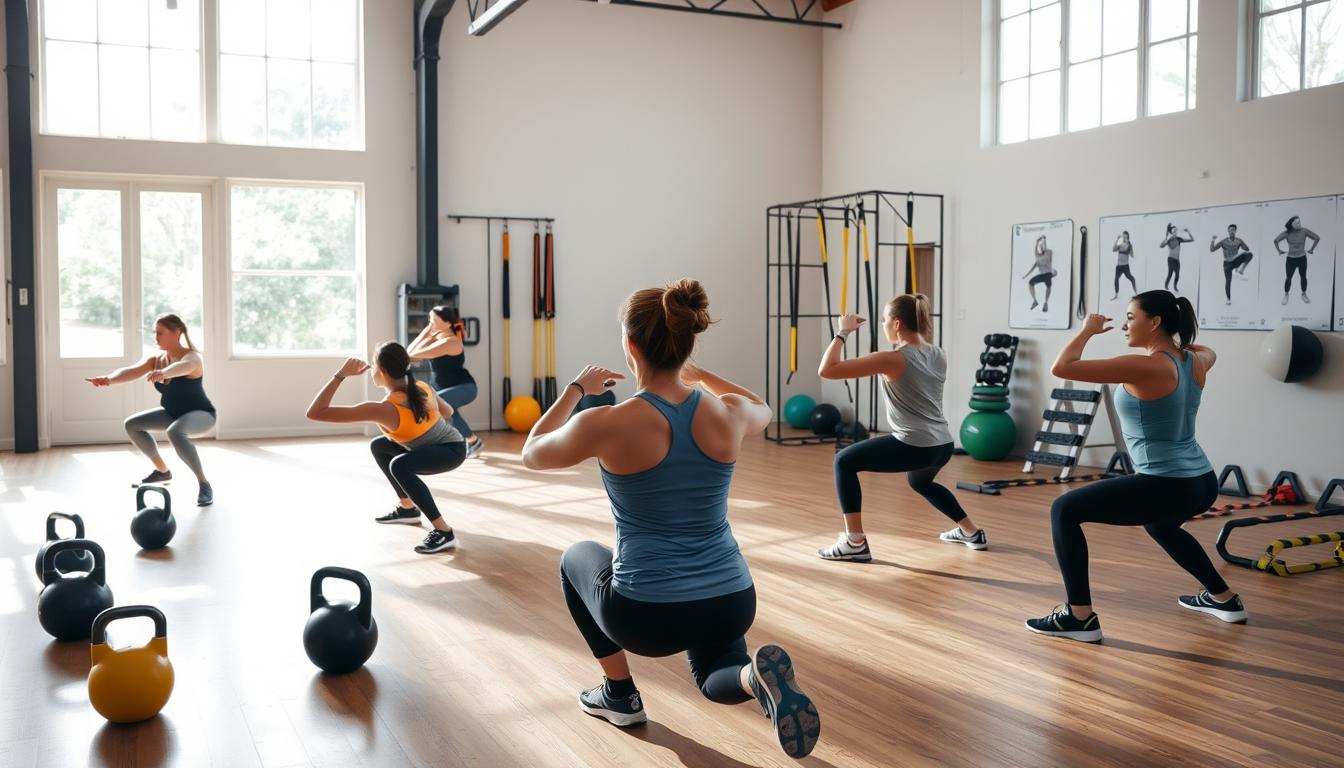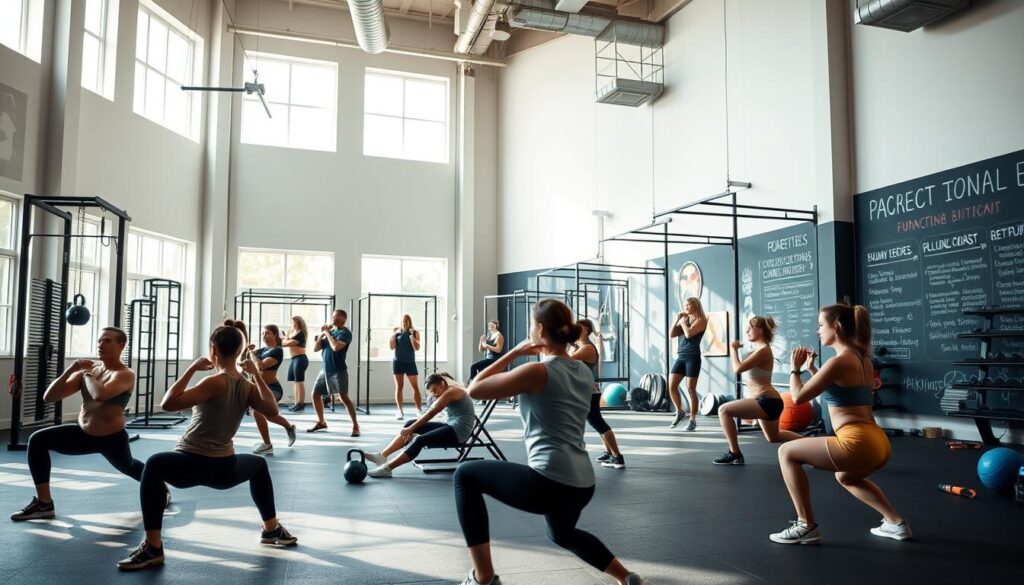Blog
Functional Fitness Training: Exercises to Improve Everyday Strength and Mobility

In today’s fast-paced world, being able to perform daily tasks with ease is more important than ever. Functional fitness training is designed to help you achieve just that by improving your strength, mobility, and coordination.
It’s about training your body to handle the demands of everyday life, from carrying groceries to playing with your kids. By incorporating exercises that mimic real-life movements, you can enhance your overall fitness and reduce the risk of injury.
By focusing on functional movements, you can improve your overall strength and mobility, making daily tasks easier and less strenuous.
Key Takeaways
- Understand the concept of functional fitness and its benefits.
- Learn exercises to improve everyday strength and mobility.
- Discover how functional fitness can enhance your overall well-being.
- Improve your coordination and balance through targeted training.
- Reduce the risk of injury by strengthening your muscles and improving flexibility.
What Is Functional Fitness and Why It Matters
Functional fitness training is designed to prepare the body for real-life movements and tasks. It’s an approach to exercise that focuses on improving strength, mobility, and coordination in ways that are directly applicable to everyday activities.
Definition and Core Principles
Functional fitness is centered around exercises that mimic daily movements, such as squatting, lifting, bending, and carrying. These exercises are designed to improve functional strength training by engaging multiple muscle groups simultaneously. The core principles include:
- Multi-planar movements that work several joints and muscle groups at once
- Exercises that improve balance and coordination
- Training that enhances overall physical functionality
By focusing on these principles, functional fitness helps individuals perform daily tasks more efficiently and reduces the risk of injury.
How It Differs from Traditional Gym Workouts
Unlike traditional gym workouts that often isolate specific muscles, functional fitness involves compound exercises that work multiple muscle groups at once. For example, a squat is a functional exercise that works the legs, glutes, and core, whereas a leg press machine isolates the legs. Additionally, functional fitness incorporates mobility exercises to improve flexibility and range of motion.
Functional fitness is not just about physical appearance; it’s about enhancing overall functionality and quality of life. As shown in the image below, functional training can involve a variety of equipment and exercises.

By understanding and incorporating functional fitness into your routine, you can experience significant improvements in your daily life, from enhanced performance in physical activities to better overall health.
The Science Behind Functional Fitness
Understanding the science behind functional fitness reveals its potential to enhance overall physical capability. Functional fitness is designed to improve our ability to perform daily tasks efficiently and safely. By focusing on integrated movements that work multiple muscle groups simultaneously, functional fitness training prepares the body for real-life activities.
Movement Patterns vs. Isolated Exercises
Unlike traditional gym workouts that often isolate specific muscles, functional fitness emphasizes movement patterns that replicate everyday actions. For example, squats and lunges mimic the movements we use to sit, stand, or walk. This approach not only strengthens muscles but also improves coordination and balance. Check out more on functional fitness training to understand its benefits.
Neurological and Muscular Benefits
Functional fitness offers significant neurological and muscular benefits. By engaging multiple muscle groups and challenging the body’s coordination, it enhances neuromuscular connections. This leads to better muscle recruitment patterns, improved reaction times, and enhanced overall physical performance. The table below summarizes some key benefits:
| Benefit | Description |
|---|---|
| Improved Coordination | Enhanced ability to perform complex movements |
| Injury Prevention | Reduced risk of injury through strengthened muscles and improved flexibility |
| Better Balance | Enhanced stability and reduced risk of falls |
By incorporating functional fitness into your routine, you can experience these benefits firsthand, leading to a more active, capable, and injury-free life.
Key Benefits of Functional Training for Daily Life
The benefits of functional training extend far beyond the gym, impacting daily activities in profound ways. By enhancing real-life strength, functional training improves overall quality of life.
Enhanced Performance in Everyday Activities
Functional training focuses on movements that are common in daily life, such as squatting, lifting, and carrying. This type of training enhances performance in everyday activities, making tasks like grocery shopping, playing with children, or doing yard work easier and less strenuous. For instance, strengthening the legs through squats can improve balance and stability, reducing the risk of falls.
Injury Prevention and Longevity
One of the significant benefits of functional training is injury prevention. By strengthening muscles and improving flexibility, individuals can reduce their risk of injury during daily activities. Moreover, functional training promotes longevity by maintaining physical function and mobility as people age, enabling them to remain independent and active.
Improved Body Awareness and Coordination
Functional training also improves body awareness and coordination, which are crucial for navigating complex environments and performing intricate tasks. Enhanced proprioception (the ability to sense the position and movement of one’s body) helps in maintaining balance and executing precise movements, contributing to overall physical competence.
In conclusion, incorporating functional training into one’s fitness routine can lead to significant improvements in daily life, from enhanced performance in everyday tasks to better injury prevention and overall physical awareness.
Assessing Your Functional Fitness Level
Assessing your functional fitness is the first step towards improving your overall strength and mobility. Functional strength training is about more than just exercising; it’s about understanding your body’s capabilities and limitations.
Simple Self-Assessment Tests
To gauge your functional fitness level, start with simple self-assessment tests. These tests can help you understand how well your body performs daily tasks and movements.
- Squat Test: Stand up from a seated position without using your hands. If you struggle, it may indicate weakness in your legs or hips.
- Balance Test: Stand on one leg for 30 seconds. Difficulty balancing could signal issues with your ankle stability or core strength.
- Push-Up Test: Perform a push-up. Struggling to complete one might indicate weakness in your upper body or poor core engagement.
Identifying Movement Limitations
Identifying movement limitations is crucial for creating a targeted training program. By recognizing the areas where you’re restricted, you can focus on exercises that will improve your range of motion and overall functional strength.
| Movement | Limitation Indicators | Possible Causes |
|---|---|---|
| Squatting | Difficulty standing up, knee pain | Weak quadriceps, tight hip flexors |
| Lunging | Pain in the knee or hip, instability | Tight hip flexors, weak glutes |
| Overhead Reaching | Shoulder pain, limited range | Tight shoulders, weak upper back |
By understanding your functional fitness level and identifying movement limitations, you can tailor your training to address these weaknesses, enhancing your overall strength and mobility.
Fundamental Mobility Exercises for Better Movement
To move better, it’s vital to incorporate fundamental mobility exercises into your routine. Mobility exercises are designed to improve the range of motion and reduce stiffness in the muscles and joints. By enhancing mobility, individuals can perform daily activities more efficiently and reduce the risk of injury.
Hip Mobility Drills
Hip mobility is crucial for maintaining flexibility and performing daily tasks such as walking or climbing stairs. Effective hip mobility drills include the lateral lunge and hip circles. These exercises help to loosen the hip joint and improve overall lower body mobility. For more detailed guidance on mobility exercises, you can refer to resources like GQ Magazine’s article on mobility exercises.
| Exercise | Reps/Sets | Benefits |
|---|---|---|
| Lateral Lunge | 3 sets of 10 reps | Improves hip flexibility |
| Hip Circles | 3 sets of 5 reps | Enhances hip joint mobility |
Shoulder and Thoracic Spine Mobility
Improving mobility in the shoulders and thoracic spine is essential for maintaining good posture and reducing the risk of shoulder injuries. Exercises such as shoulder rolls and thoracic spine rotations can help to increase flexibility and range of motion in these areas.
Ankle and Wrist Mobility Exercises
Ankle and wrist mobility exercises are vital for maintaining flexibility in these often-overlooked areas. Simple exercises like ankle circles and wrist extensions can be performed daily to improve mobility.
Dynamic Warm-up Routine
A dynamic warm-up routine is an excellent way to prepare the body for more intense exercise. It involves moving the joints through a range of motion while keeping the muscles active. Examples include leg swings and arm circles. Incorporating a dynamic warm-up into your routine can enhance performance and reduce the risk of injury.
Core Functional Strength Training Exercises
Effective functional training involves a combination of exercises that improve strength, mobility, and coordination. These exercises are designed to mimic daily activities and enhance overall physical fitness.
Squat Variations for Lower Body Strength
Squats are a fundamental exercise for building lower body strength. Variations such as bodyweight squats, goblet squats, and barbell back squats can be used to challenge different muscle groups. For example, a goblet squat using a kettlebell can help improve strength and mobility in the hips and legs.
To perform a goblet squat, hold a kettlebell at your chest, stand with your feet shoulder-width apart, and lower your body down into a squat. Keep your back straight and your knees behind your toes.
Push and Pull Movements for Upper Body
Push and pull exercises are essential for building upper body strength. Push-ups, dumbbell presses, and rows are effective exercises that target different muscle groups. For instance, a kettlebell swing is a dynamic exercise that combines elements of both push and pull movements.
The kettlebell swing is a versatile exercise that works multiple muscle groups simultaneously. To perform a kettlebell swing, hold a kettlebell with both hands, hinge at the hips, and swing the kettlebell back between your legs, then up to chest height, using your hips and legs to generate power.
Rotational Exercises for Core Power
Rotational exercises are critical for building core strength and power. Exercises like Russian twists, medicine ball throws, and kettlebell rotations can help improve rotational strength. These exercises can be performed with various equipment, including kettlebells and medicine balls.
For example, a kettlebell rotation involves holding a kettlebell and rotating your torso to generate power. This exercise can help improve core strength and enhance overall functional fitness.
Carrying Exercises for Total Body Strength
Carrying exercises, such as farmer’s carries and kettlebell carries, are effective for building total body strength. These exercises require engaging multiple muscle groups simultaneously, improving overall strength and endurance.
| Exercise | Primary Muscle Groups | Equipment |
|---|---|---|
| Goblet Squat | Legs, Glutes | Kettlebell |
| Kettlebell Swing | Legs, Glutes, Core | Kettlebell |
| Russian Twist | Core, Obliques | Medicine Ball or Kettlebell |
By incorporating these exercises into your functional training routine, you can improve overall strength, mobility, and coordination. Remember to start with lighter weights and progress gradually to more challenging exercises.
Kettlebell Workouts for Real-Life Strength
Kettlebells are a powerful tool for building strength that translates to everyday activities. By incorporating kettlebell exercises into your workout routine, you can enhance your functional fitness, improve coordination, and boost overall strength.
Kettlebell Swing Technique and Benefits
The kettlebell swing is a fundamental exercise that targets the posterior chain, including the glutes and hamstrings. To perform a kettlebell swing, start by standing with your feet shoulder-width apart, then hinge at the hips to swing the kettlebell back between your legs. Finally, swing the kettlebell up to chest height, squeezing your glutes and pushing your hips forward. This exercise improves hip mobility, strengthens the lower back, and enhances cardiovascular endurance.
Proper Technique: Keep your back straight, engage your core, and avoid rounding your back. Practice with a light kettlebell to master the technique before increasing the weight.
Turkish Get-Up for Full-Body Integration
The Turkish get-up is a complex exercise that involves multiple joints and muscle groups, making it an excellent choice for full-body integration. It requires coordination, strength, and control. To perform a Turkish get-up, start in a supine position with a kettlebell held in one hand, then follow a series of movements that take you to a standing position, and back down again.
Benefits: Improves overall strength, mobility, and coordination. It’s a compound exercise that engages the core, legs, and upper body.
Simple Kettlebell Circuit Workouts
Kettlebell circuit workouts are an efficient way to improve cardiovascular fitness and strength. A simple circuit might include kettlebell swings, goblet squats, and kettlebell rows. Perform each exercise for a set duration or number of repetitions before moving to the next, resting only after completing the circuit.
- Kettlebell Swings: 30 seconds
- Goblet Squats: 15 reps
- Kettlebell Rows: 20 reps per arm
Tips: Start with shorter circuits and gradually increase the duration as your fitness level improves. Focus on proper form to maximize the benefits and minimize the risk of injury.
Translating Functional Fitness to Everyday Activities
The benefits of functional fitness extend far beyond the gym, impacting everyday activities in profound ways. By focusing on exercises that mimic real-life movements, functional fitness training helps individuals perform daily tasks more efficiently and safely.
Improving Household Tasks and Yard Work
Functional fitness can significantly improve one’s ability to perform household tasks and yard work. Exercises like squats, lunges, and deadlifts strengthen the muscles used for lifting, carrying, and bending, making tasks such as grocery shopping, gardening, and cleaning more manageable. For instance, strengthening the core and leg muscles can help prevent injuries while lifting heavy objects or shoveling snow.
As stated by the American Council on Exercise (ACE), “Functional training can help improve an individual’s ability to perform daily tasks and reduce the risk of injury.” This is particularly relevant for tasks that require lifting, bending, or carrying, where functional fitness can make a significant difference.
Enhancing Recreational Activities and Sports
Functional fitness also enhances performance in recreational activities and sports. By improving strength, flexibility, and coordination, individuals can enjoy their favorite hobbies and sports with more energy and less risk of injury. For example, exercises that improve rotational strength can enhance golf swings, while plyometric training can improve jumping ability in basketball.
Key benefits include:
- Increased power and endurance
- Improved agility and reaction time
- Enhanced overall physical fitness
Supporting Healthy Aging and Independence
One of the most significant advantages of functional fitness is its role in supporting healthy aging and independence. As people age, maintaining strength, flexibility, and balance becomes crucial for preventing falls and maintaining mobility. Functional fitness exercises tailored for older adults can help them stay active and independent, improving their quality of life.
“Functional fitness is essential for maintaining independence as we age,” notes a study published in the Journal of Aging Research. By incorporating functional fitness into their routine, older adults can reduce their risk of falls and maintain their ability to perform daily tasks.
Creating Your Functional Fitness Program
A well-structured functional fitness program can significantly improve your overall strength and mobility. To achieve this, it’s essential to understand how to tailor your training to your fitness level and goals.
Beginner, Intermediate, and Advanced Progressions
Progressing in functional fitness involves gradually increasing the intensity and complexity of exercises. For beginners, starting with bodyweight exercises or light resistance bands is advisable. As you progress to intermediate levels, you can introduce more challenging movements like squats, lunges, and push-ups with resistance. Advanced training might include complex movements such as kettlebell swings or burpees.
| Fitness Level | Example Exercises | Intensity |
|---|---|---|
| Beginner | Bodyweight squats, wall push-ups | Low |
| Intermediate | Squats with dumbbells, lunges | Moderate |
| Advanced | Kettlebell swings, burpees | High |
Sample Weekly Training Schedule
A balanced functional fitness program should be performed 2-3 times a week, allowing for recovery days in between. Here’s a sample schedule:
- Monday: Lower body and core strength (squats, lunges, planks)
- Wednesday: Upper body and mobility (push-ups, rows, shoulder mobility exercises)
- Friday: Full-body workout (kettlebell swings, burpees, mountain climbers)
Equipment Essentials for Home Workouts
While bodyweight exercises are sufficient for a good workout, having some basic equipment can enhance your functional fitness program. Essentials include resistance bands, dumbbells, and a stability ball. For more advanced training, kettlebells and a pull-up bar can be beneficial.
By understanding how to progress your training, scheduling your workouts effectively, and utilizing the right equipment, you can create a functional fitness program that meets your needs and helps you achieve your fitness goals.
Conclusion: Embracing Functional Fitness for a Stronger, More Mobile Life
As we’ve explored throughout this article, Functional Fitness is about more than just exercise – it’s a way to improve everyday strength and mobility. By incorporating Functional Fitness training into your lifestyle, you can enhance your performance in daily activities, reduce the risk of injury, and maintain independence as you age.
To start your Functional Fitness journey, begin by assessing your current fitness level and identifying areas for improvement. Focus on exercises that work multiple muscle groups at once, such as squats, lunges, and push-ups. Incorporate mobility drills to improve your range of motion and reduce stiffness.
With consistent practice and patience, you can develop the strength, mobility, and coordination needed to tackle daily tasks with confidence. Whether you’re looking to improve your overall health or enhance your athletic performance, Functional Fitness can help you achieve your goals. So why wait? Start your Functional Fitness journey today and discover a stronger, more mobile you.

